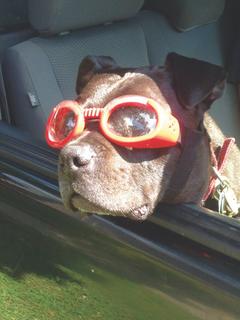One frigid February afternoon, Naomi Austin and her dog, Petey, headed out for a walk along the railroad tracks. What began as an average trek soon took a turn when Austin saw that a dog was following them. The pit bull’s fur was disheveled and sparse. Its gait was wobbly and lizardlike. Fearing a possible confrontation, Austin and Petey pressed home, but the unfamiliar dog followed them to their door. Austin realized she needed to help. After treating his numerous physical ailments, she adopted the stray and named him Bosko. But it wasn’t long before she noticed fear was controlling her new companion’s life. She turned to Dana Emerson, BS, VT, KPA-CTP, a training specialist at the Veterinary Medical Center (VMC), for help.
Many dogs suffer from fears that impair their quality of life, but behavioral therapy—an emerging field in veterinary medicine that addresses the common psychological issues many pets face—can provide relief. Emerson emphasizes the need for space, which can be challenging in many veterinary clinic settings. Many pets cannot handle walking through a lobby filled with patients or performing nose work, a practice that encourages dogs to sniff out hidden rewards, in a small exam room. Despite these challenges, the behavioral staff at the VMC works creatively to help dogs become confident and loving.
When Emerson first met Bosko, she worked around his anxiety by scheduling private early-morning sessions and finding large work areas to accommodate his need for space. She used nose work and other novel therapies to help grow Bosko’s confidence. He continues to make strides toward living more comfortably with the help of Emerson’s care.
“Bosko is a great dog, and we enjoy having him in our household,” says Austin. “But, because of unknowable events in his puppyhood, he is profoundly damaged, and he simply could not have survived without the University’s help.”
Photo courtesy of Naomi Austin

